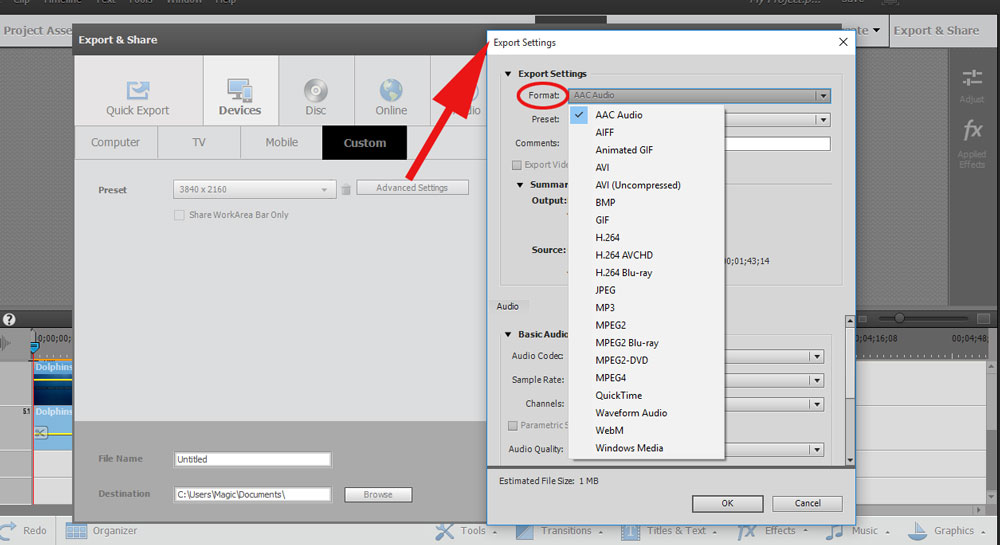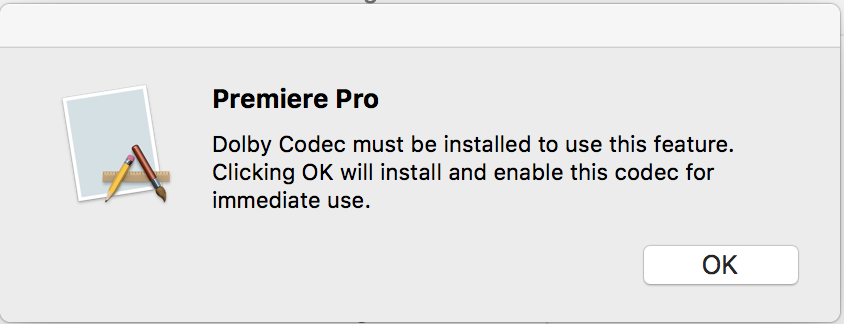Install Dolby Codec Premiere
Click the 'Install' option from the context menu. A notification appears indicating that the codec will be installed. Click 'Continue.' The codec is installed to the computer and now appears in Adobe Premiere Pro. The Dolby® Media Decoder is a part of the Dolby Media Producer Suite, the professional software designed to support all Dolby audio codecs used in mastering Blu-ray Disc™, DVD-Video, DVD-Audio, and online streaming and downloadable formats. Problem solved with another minor problem: Using another user with admin rights the 2 codecs has been installed. I assume that by my 7 days trial installation something might have been remembered.
- Dolby Codec Premiere Pro
- Dolby Codec Premiere Pro
- Dolby Codecs For Windows 10
- Install Dolby Codec Premiere Pro
- Dolby Codec For Premiere
- Dolby Digital Codec
MPEG-2, MPEG2-DVD, MPEG-2-Blu-ray, and MXF OP1a are missing from the format pop-up menu in Adobe Media Encoder CS6. Dolby Digital is also missing as an audio codec if you choose one of the H.264 presets.

You purchased an annual membership for Adobe Creative Cloud.
Note:
As of September 15, 2017, Adobe Creative Cloud applications now rely on your operating system (OS) to decode/encode Dolby Digital and Dolby Digital Plus audio formats. Adobe no longer bundles the native libraries from Dolby with Creative Cloud products.
Dolby Codec Premiere Pro
For information about how this change affects Dolby audio playback in your product, see Adobe Creative Cloud apps use native OS support for Dolby.
Install the latest update to the Adobe Media Encoder, 6.01 or later.
To download the update, choose Help > Updates from within any of the CS6 products and follow the onscreen instructions.
Twitter™ and Facebook posts are not covered under the terms of Creative Commons.
Dolby Codec Premiere Pro
Legal Notices Online Privacy Policy
When I try to import any video file (e.g. AVI files) in Adobe Premiere Pro cc in my Macbook Air, I get this error:'codec missing or unavailable'
What to do about it?

4 Answers
AVI is just a container for a video format, and can contain videos encoded in different formats. The error you're seeing says that Adobe Premiere does not know how to process the video format that's within the AVI file.
- First, you would have to find out (or know) the codec used for the video within the AVI file and then download and install the appropriate codec on your system.
- To find out the codec for the file, examine it using a tool like QuickTime or VLC and see if you can use the Inspectors in these to get the video and audio codecs for your file.
- If these two don't help, you would have to use a media information tool like MediaInspector or AviInfo on OS X or GSpot on Windows. Then search and install the codec for the file.
Here's some additional explanation and information from Adobe on 'Troubleshoot file formats and codecs':
Video-recording devices and video software applications encode files in a specific file format, such as AVI, QuickTime (MOV), and Windows Media (WMV). For a list of the file formats that Adobe Premiere Elements supports, search 'Supported file formats in Adobe Premiere Elements ' in the Adobe Knowledgebase.
Some video file formats, including AVI and MOV, are container file formats. The data inside these container files is encoded according to a particular codec. Codecs are algorithms for compressing video and audio data. Many different codecs exist.
Dolby Codecs For Windows 10
For example, an AVI file can be encoded with the DV codec, a commercial codec (such as DivX), a Motion JPEG codec, among others. (Camcorders that record to miniDV tapes use the DV codec. Some still-image cameras use the Motion JPEG coded.)
Ibanez guitar serial numbers search. Adobe Premiere Elements sometimes cannot decode video files that were created with a poorly designed codec or a codec that is not installed on your computer.
Knowing the format and, when applicable, the codec of the files you are working with helps you use these solutions. To gather this information, do one or more of the following tasks:
- Open the file in Apple QuickTime Player and choose Window > Show Movie Inspector.
- If the file is from a camcorder, camera, or other video-recording device, see the device's documentation, or locate the device's specifications on the manufacturer's website.
- Open the file in a third-party application that analyzes media files, such as MediaInfo or GSpot 2.70.
I encountered this recently when my Kodak digital camera recorded in .MOV, and I figured importing it should be a breeze. Nope. I kept running into a very unhelpful 'File format contains no audio or video' error when dragging the .MOV file into my clip bin.
The solution was so simple it was almost ridiculous. After Googling for a bit, I found a YouTube saying all you had to do was change the filename extension from .MOV to .MP4, and boom - done. I didn't believe it at first, but sure enough - it worked like a charm! :-)
This was on Adobe Premiere Pro CC 2015, Windows 8.
Install Dolby Codec Premiere Pro
It's very simply.HOW TO FIX: download avid codex pack, install it (on mac -> library->QuickTime), restart and reopen Adobe Premiere.http://avid.force.com/pkb/articles/en_US/download/Avid-QuickTime-Codecs-LE
Dolby Codec For Premiere
All I did was add '.mov' to the file name and all is well!!!